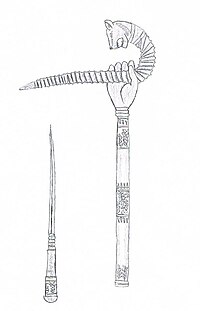Fakir's Crutch
| Fakir's Crutch | |
|---|---|

|
|
| Information | |
| Weapon type: | Club, dagger |
| Use: | civil weapon |
| Working time: | around 16th to 19th century |
| Distribution: | India |
| Overall length: | about 61 cm |
| Blade length: | about 29 to 36 cm. Dagger about 24 cm |
| Lists on the subject | |
The Fakir's Crutch (English for the fakir's stick ) is a walking stick from India . It was worn by the Indian fakirs as a defensive weapon. Sometimes the terms bairagi or khundli p'hansi are also used. The fakirs were forbidden to carry weapons, so they came up with weapons of their own that did not fall under this ban (for example madu ).
description
The fakir's crutch is usually made entirely of metal and has the shape of a short walking stick. This stick supported the arm while sitting. Some versions have a heavy handle that can effectively be used as a club . Many versions have a hidden, long dagger in the shaft. They are very different in shape and decoration. A popular motif for the handle is a hand holding an antelope horn on one side and a snake with a tiger's head on the other. Some are very simple, others are very elaborate with gilding or taws .
See also
literature
- Lord Egerton of Tatton: A Description of Indian and Oriental Armor. , 1896, page 47, limited preview in Google Book search.
- George Cameron Stone : A Glossary of the Construction, Decoration and Use of Arms and Armor in All Countries and in All Times. With an introduction by Donald J. LaRocca. Courier Dover Publications, Mineola NY 1999, ISBN 0-486-40726-8 (reprint).
- Gayatri Nath Pant: Indian Arms and Armor: Swords and daggers. Vol. 2, New Delhi Army Educational Stores, 1980, OCLC 256520213 , 45.
- Claude Blair et al. a .: The complete encyclopedia of arms & weapons: the most comprehensive reference work ever published on arms and armor. Publisher Bonanza Books, 1986, ISBN 978-0-517-48776-1 , page 179.
Individual evidence
- ↑ Bairagi in the Royal Armories / Leeds, available online, (English, accessed on December 23, 2012)
- ↑ George Cameron Stone: A glossary of the construction, decoration and use of arms and armor in all countries and in all times. 1934, page 354.
Web links
- Indian fakir with a bairagi, historical photo
- Science Museum : Iron divan crutch with concealed dagger, reputedly Persian, 1801-1900
- Copies from Oriental Arms: [1] , [2] , [3] , [4]
